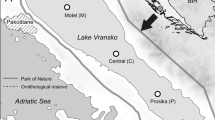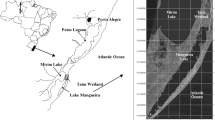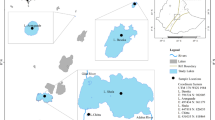Abstract
We investigated nine Pampean shallow lakes (Argentina) across a moisture gradient (mean annual precipitation 1,000–500 mm), under the framework of a network project of lake monitoring whose main objective was to analyse the responses of ecosystems to different stressors associated with human activities. We postulate that species bloom in different shallow lakes will be determined mainly by local optical features, nutrients and salinity. We analysed the phytoplankton structure during the warm season 2012–2013, identifying those species and functional groups that proliferate in the lakes. Most lakes showed high phytoplankton biomass, except a saline lake located in the driest part of the gradient and an inorganic turbid lake. In some lakes, cyanobacteria blooms occurred in summer, persisting until autumn. Small colonial cyanobacteria and small fast-growing chlorophytes were abundant in most turbid enriched and anthropogenically impacted systems. Lowest species and functional diversity occurred in the saline lake. Multivariate analysis indicated that the phytoplankton structure was mainly defined by conductivity, transparency and variables associated with the trophic state, also reflecting the importance of the geographical location. Our results evidenced the vulnerability of most shallow lakes in the region to water level fluctuations, eutrophication and canalization.








Similar content being viewed by others
References
Allende, L., G. Tell, H. Zagarese, A. Torremorell, G. Pérez, J. Bustingorry, R. Escaray & I. Izaguirre, 2009. Phytoplankton and primary production in clear-vegetated, inorganic-turbid, and algal-turbid shallow lakes from the pampa plain (Argentina). Hydrobiologia 624: 45–60.
Atlas Ambiental de Buenos Aires, 2008. http://atlasdebuenosaires.gov.ar.
APHA AWWA WEF, 2005. Standard Methods for the Examination of Water & Wastewater. American Public Health Association, American Water Works Association, Water Environment Federation, Washington.
Borics, G., B. Tóthmérész, B. A. Lukács & G. Várbíró, 2012. Functional groups of phytoplankton shaping diversity of shallow ecosystems. Hydrobiologia 698: 251–262.
Casco, M. A., M. E. Mac Donagh, M. G. Cano, L. C. Solari, M. C. Claps & N. A. Gabellone, 2009. Phytoplankton and epipelon response to turbid and clear phases in a seepage lake (Buenos Aires, Argentina). – international. Review of Hydrobiology 94: 153–168.
Chaparro, G., M. C. Marinone, R. J. Lombardo, M. R. Schiaffino, A. de Souza Guimarães & I. O’Farrell, 2011. Zooplankton succession during extraordinary drought-flood cycles: a case study in a South America floodplain lake. Limnologica 41: 371–381.
Chaparro, G., P. Kandus & I. O’Farrell, 2013. Effect of spatial heterogeneity on zooplankton diversity: a multi-scale habitat approximation in a floodplain lake. River Research and Applications. doi:10.002/rra.2711.
Codd, G. A., J. Lindsay, F. M. Young, L. F. Morrison & J. S. Metcalf, 2005. Harmful Cyanobacteria. From mass mortalities to management measures. In Huisman, J., C. P. Matthijs & P. M. Visser (eds), Harmful Cyanobacteria. Aquatic Ecology Series, 3. Springer, Dordrecht.
Downing, J. A., Y. T. Prairie, J. J. Cole, C. M. Duarte, L. J. Tranvik, R. G. Striegl, W. H. McDowell, P. Kortelainen, N. F. Caraco & J. M. Melack, 2006. The global abundance and size distribution of lakes, ponds, and impoundments. Limnology and Oceanography 51: 2388–2397.
Fermani, P., N. Diovisalvi, A. Torremorell, L. Lagomarsino, H. Zagarese & F. Unrein, 2013. The microbial food web structure of a hypertrophic warm températe shallow lake, as affected by contrasting zooplankton assemblages. Hydrobiologia 714: 115–130.
Fernández Cirelli, A. & P. Miretzky, 2002. Lagos poco profundos de la Pampa Argentina. Relación con aguas subterráneas someras. In Fernández Cirelli, A. & G. Chalar Marquisá (eds). El agua en Iberoamérica. De la limnología a la gestión en Sudamérica. CYTED XVII, CETA- Centro de Estudios Transdisciplinarios del Agua, Facultad de Ciencias Veterinarias, Buenos Aires: 43–52.
Fonseca, B. M. & C. E. M. Bicudo, 2008. Phytoplankton seasonal variation in a shallow stratified eutrophic reservoir (Garcas Pond, Brazil). Hydrobiologia 600: 267–282.
Geraldi, A. M., M. C. Piccolo & G. M. E. Perillo, 2011. El rol de las lagunas bonaerenses en el paisaje pampeano. Ciencia Hoy 21: 9–14.
Gómez, S.E. & N. I. Toresani, 1998. Región 3: Pampas. In Canevari, P., D. E. Blanco, G. Castro & I. Davidson (eds), Los humedales de la Argentina. Clasificación, situación actual, conservación y legislación. Wetlands International, Secretaría de Recursos Naturales y Desarrollo Sustentable, 46, Buenos Aires: 98–114.
Hillebrand, H., C.-D. Durselen, D. Kirshtel, U. Pollingher & T. Zohary, 1999. Biovolume calculation for pelagic and benthic microalgae. Journal of Phycology 35: 403–424.
Izaguirre, I., L. Allende, R. Escaray, J. Bustingorry, G. Pérez & G. Tell, 2012. Comparison of morpho-functional phytoplankton classifications in human-impacted shallow lakes with different stable states. Hydrobiologia 698: 203–216.
Krasznai, E., G. Borics, G. Várbíró, A. Abonyi, J. Padisák, Cs Deák & B. Tóthmérész, 2010. Characteristics of the pelagic phytoplankton in shallow oxbows. Hydrobiologia 639: 261–269.
Kruk, C., V. L. M. Huszar, E. T. H. M. Peeters, S. Bonilla, L. Costa, M. Lürling, C. S. Reynolds & M. Scheffer, 2010. A morphological classification capturing functional variation in phytoplankton. Freshwater Biology 55: 614–627.
Magurran, A. E., 2008. Maesuring Biological Diversity. Blackwell Publishing, Malden/Oxford.
Llames, M. E., L. Lagomarsino, N. Diovisalvi, P. Fermani, A. M. Torremorell, G. Pérez, F. Unrein, J. Bustingorry, R. Escaray, M. Ferraro & H. Zagarese, 2009. The effects of light availability in shallow, turbid waters: a mesocosm study. Journal of Plankton Research 31: 1517–1529.
Maidana, N. & O. E. Romero, 1995. Diatoms from the hypersaline “La Amarga” Lake (La Pampa, Argentina). Cryptogamie, Algologie 16: 173–188.
Mancini, M., V. Salinas, F. Biolé, G. Morra & H. Montenegro, 2013. Nuevo registro para la Provincia de Córdoba (Argentina) y aportes a la ecología de Parapimelodus valenciennis (Pisces, Pimelodidae). BioScriba 6: 1–8.
Marker, A. F. H., A. Nusch, H. Rai & B. Riemann, 1980. The measurement of photosynthetic pigments in freshwater and standardization of methods: conclusions and recommendations. Archiv fur Hydrobiologie Beihandlung Ergebnisse der Limnologie 14: 91–106.
Naselli-Flores, L., J. Padisák, M. T. Dokulil & I. Chorus, 2003. Equilibrium/steady state concept in phytoplankton ecology. Hydrobiologia 502: 395–403.
Nicholls, K. H., 2003. Chrysophyceae algae. In Wehr, J. D. & R. G. Sheath (eds), Freshwater Algae of North America. Ecology and Classification. Academic Press, New York.
OECD, 1982. Eutrophication of Waters, Monitoring, Assessment and Control. Organisation for Economic Cooperation and Development, Paris.
O’Farrell, I., R. Sinistro, I. Izaguirre & F. Unrein, 2003. Do steady state assemblages occur in shallow lentic environments from wetlands? Hydrobiologia 502: 197–209.
O’Farrell, I., I. Izaguirre, G. Chaparro, F. Unrein, R. Sinistro, H. Pizarro, P. L. Rodríguez, P. de Tezanos Pinto, R. Lombardo & G. Tell, 2011. Water level variation as the main driver of the alternation between a free-floating plant and a phytoplankton dominated state: a long term study in a floodplain lake. Aquatic Science 73: 275–287.
Padisák, J. & C. S. Reynolds, 2003. Shallow lakes: the absolute, the relative, the functional and the pragmatic. Hydrobiologia 506(509): 1–11.
Padisák, J., L. Crossetti & L. Naselli-Flores, 2009. Use and misuse in the application of the phytoplankton functional classification: a critical review with updates. Hydrobiologia 621: 1–19.
Paerl, H. W. & R. S. Fulton, 2006. Ecology of harmful cyanobacteria. In Graneli, E. & J. Turner (eds), Ecology of Harmful Marine Algae. Springer-Verlag, Berlin: 95–107.
Paerl, H. W. & J. Huisman, 2009. Climate change: a catalyst for global expansion of harmful cyanobacterial blooms. Environmental Microbiology Reports 1: 27–37.
Paerl, H. W. & V. J. Paul, 2012. Climate change: links to global expansion of harmful cyanobacteria. Water Research 46: 1349–1363.
Paul, V. J., 2008. Global warming and cyanobacterial harmful algal blooms. In Hudnell, H. K. (ed.), Cyanobacterial harmful algal blooms: state of the science and research needs. Springer, New York: 239–257.
Pérez, G. L., L. Lagomarsino & H. E. Zagarese, 2013. Optical properties of highly turbid shallow lakes with contrasting turbidity origins: the ecological and water management implications. Journal of environmental management 130: 207–220.
Quirós, R., 1988. Relationships between air temperature, depth, nutrients and chlorophyll in 103 Argentinian lakes. Verhandlungen des Internationalen Verein Limnologie 23: 647–658.
Quirós, R., 2004. Sobre la Morfología de las Lagunas Pampeanas. Serie de Documentos de Trabajo del Área de Sistemas de Producción Acuática. Departamento de Producción Animal, Facultad de Agronomía, Universidad de Buenos Aires, Argentina.
Quirós, R. & E. Drago, 1999. The environmental state of Argentinean lakes: an overview. Lakes and Reservoirs: Research and Management 4: 55–64.
Quirós, R., M. B. Boveri, C. A. Petrachi, A. M. Renella, J. J. Rosso, A. Sosnovsky & H. T. von Bernard, 2006. Los efectos de la agriculturización del humedal pampeano sobre la pampeano sobre la eutrofización de sus lagunas. In Tundisi, J. G. T., Matsumura-Tundisi & C. Sidagis Galli (eds), Eutrofização na América do Sul: Causas, conseqüèncias e tecnologias de gerenciamento e controle: 1–16.
Reynolds, C. S., 1994. The long, the short and the stalled: on the attributes of phytoplankton selected by physical mixing in lakes and rivers. Hydrobiologia 289: 9–21.
Reynolds, C. S., 2006. The Ecology of Phytoplankton. Cambridge University Press, Cambridge.
Reynolds, C. S., 2007. Variability in the provision and function of mucilage in phytoplankton: facultative responses to the environment. Hydrobiologia 578: 37–45.
Reynolds, C. S., V. Huszar, C. Kruk, L. Naselli Flores & S. Melo, 2002. Towards a functional classification of the freshwater phytoplankton. Journal of Plankton Research 24: 417–428.
Rojo, C. & M. Álvarez-Cobelas, 2003. Are there steady-state phytoplankton assemblages in the field? Hydrobiologia 502: 3–12.
Salmaso, N. & J. Padisák, 2007. Morpho-functional groups and phytoplankton development in two deep lakes (Lake Garda, Italy and Lake Stechlin, Germany). Hydrobiologia 578: 97–112.
Salmasso, N., L. Naselli-Flores & J. Padisák, 2012. Impairing the largest and most productive forest on our planet: how do human activities impact phytoplankton? Hydrobiologia 698: 375–384.
Scheffer, M., 2009. Critical Transitions in Nature and Society. Princeton University Press, Princeton/Oxford.
Scheffer, M. & S. R. Carpenter, 2003. Catastrophic regime shifts in ecosystems: linking theory to observation. Trends in Ecology & Evolution 18: 648–656.
Scheffer, M., S. Szabó, A. Gragnani, E. H. van Ness, S. Rinaldi, N. Kautsky, J. Norberg, R. M. M. Roijackers & R. J. M. Franken, 2003. Floating plant dominance as a stable state. Proceedings of the National Academy of Science 100: 4040–4045.
Scheffer, M. & E. van Nes, 2007. Shallow lakes theory revisited: various alternative regimes driven by climate, nutrients, depth and lake size. Hydrobiologia 584: 455–466.
Scheffer, M., S. H. Hosper, M. L. Meijer, B. Moss & E. Jeppesen, 1993. Alternative Equilibria in Shallow Lakes. Trends in Ecology and Evolution 8: 275–279.
Sinistro, R., S. Buitrago Giraldo, A. M. Renella, A. Mamani & I. Izaguirre, 2013. Limnological changes in two shallow lakes from an urban reserve throughout a complete hydrological cycle: proposals for restoration and management. International Journal of Environment and Health 6: 381–397.
Solari, L. & M. E. Mac Donagh, 2014. Lotic and lentic environments of the Pampean plain. Advances in Limnology 65: 143–165.
Sun, J. & D. Liu, 2003. Geometric models for calculating cell biovolume and surface surface area for phytoplankton. Journal of Plankton Research 25: 1331–1346.
ter Braak, C. J. F. & P. Smilauer, 2002. CANOCO Reference Manual and CanoDraw for Windows User´s Guide: Software for Canonical Community Ordination (version 4.5). Microcomputer Power, New York.
Tolotti, M., E. Rott, H. Thies & R. Psenner, 2005. Functional species groups of phytoplankton in relation to lake restoration: a long term study of Piburger See, Austria. Verhanlungen der Vereingung fuer theorestische und angewandte Limnologie 29: 891–894.
Torremorell, A., J. Bustingorry, R. Escaray & H. Zagarese, 2007. Seasonal dynamics of a large, shallow lake, laguna Chascomús: the role of light limitation and other physical variables. Limnologica 37: 100–108.
Unrein, F., I. O’Farrell, I. Izaguirre, R. Sinistro, M. dos Santos Afonso & G. Tell, 2010. Phytoplankton response to pH rise in a N-limited floodplain lake: relevance of N2-fixing heterocystous cyanobacteria. Aquatic Sciences 72: 179–190.
Utermöhl, M., 1958. Zur Vervollkommung der quantitativen Phytoplankton Methodik. Mitteilungen Internationale Vereinigung Limnologie 9: 1–38.
Venrick, E. L., 1978. How many cells to count? In Sournia, A. (ed.), Phytoplankton Manual. UNESCO, Paris: 167–180.
Viglizzo, E. F., F. C. Frank & L. Carreño, 2006. Situación ambiental en las ecorregiones Pampa y Campos y Malezas. In Brown, A., U. Martínez Ortíz, M. Acerbi & J. Corcuera (eds.), La situación ambiental argentina 2005. Fundación Vida Silvestre Argentina, Buenos Aires: 263–278.
Wiedner, C., B. Nixdorf, R. Heinz, B. Wirsing, U. Neumann & J. Weckesser, 2002. Regulation of cyanobacteria and microcystin dynamics in polymictic shallow lakes. Archiv für Hydrobiologie 155: 383–400.
Zohary, T., J. Padisák & L. Naselli-Flores, 2010. Phytoplankton in the physical environment: beyond nutrients, at the end, there is some light. Hydrobiologia 639: 261–269.
Acknowledgments
This investigation was financed by the network project PAMPA2 (CONICET). We thank the team of the following laboratories: Limnology at the University of Buenos Aires, Photobiology at the IIB-INTECH of Chascomús, and Instituto Argentino de Oceanografía, IADO, Bahía Blanca for the cooperation in the field campaigns at the different sampling sites. We also thank R. Escaray and J. Bustingorry for some of the nutrient analyses. We thank the two reviewers for their comments that improved the manuscript.
Author information
Authors and Affiliations
Corresponding author
Additional information
Guest editors: I. Izaguirre, L. A. Miranda, G. M. E. Perillo, M. C. Piccolo & H. E. Zagarese / Shallow Lakes from the Central Plains of Argentina
Rights and permissions
About this article
Cite this article
Izaguirre, I., Sánchez, M.L., Schiaffino, M.R. et al. Which environmental factors trigger the dominance of phytoplankton species across a moisture gradient of shallow lakes?. Hydrobiologia 752, 47–64 (2015). https://doi.org/10.1007/s10750-014-2007-1
Received:
Revised:
Accepted:
Published:
Issue Date:
DOI: https://doi.org/10.1007/s10750-014-2007-1




